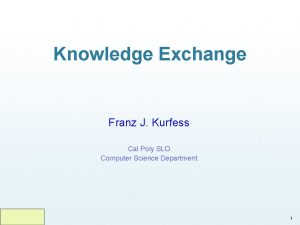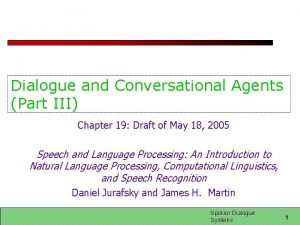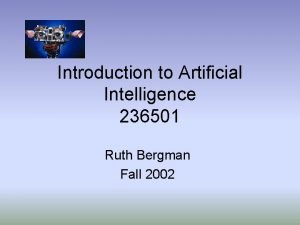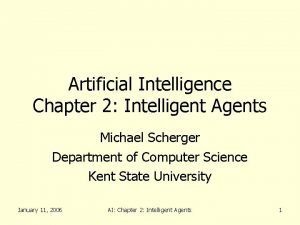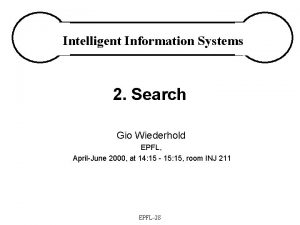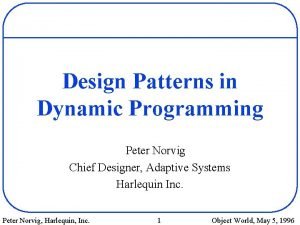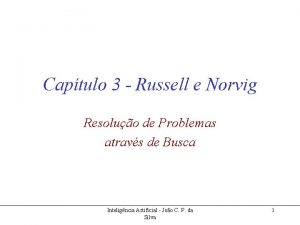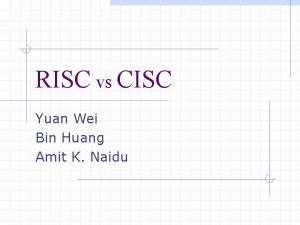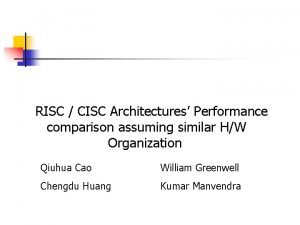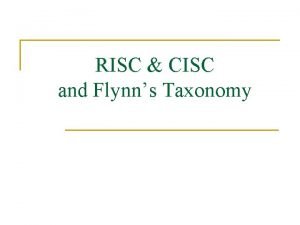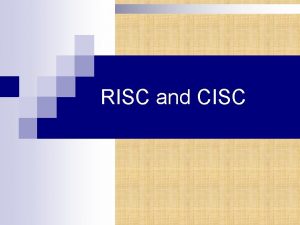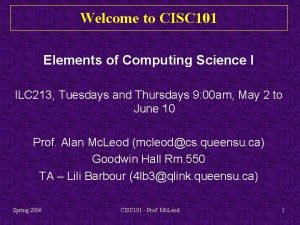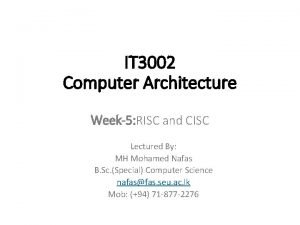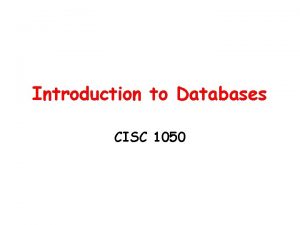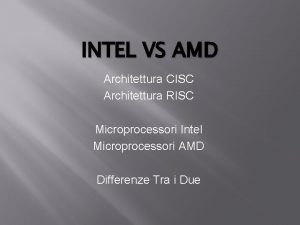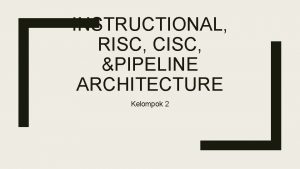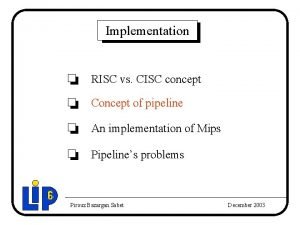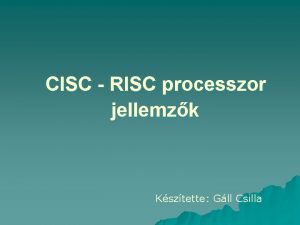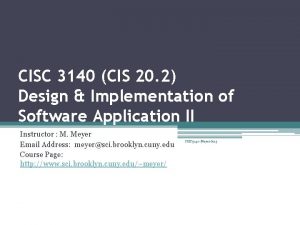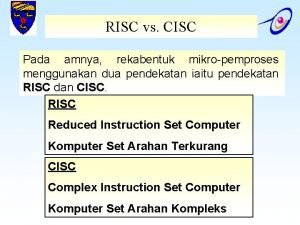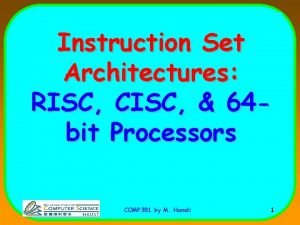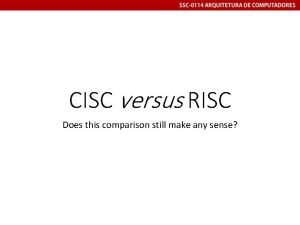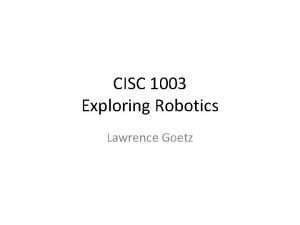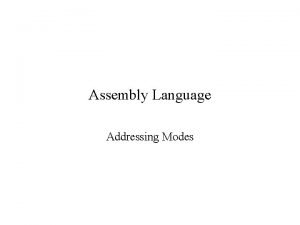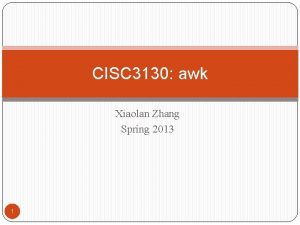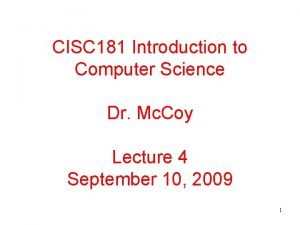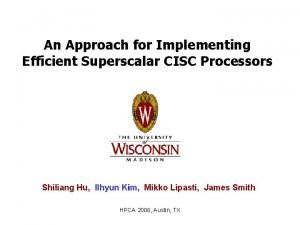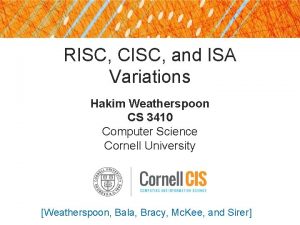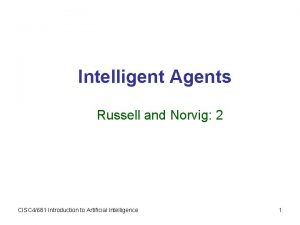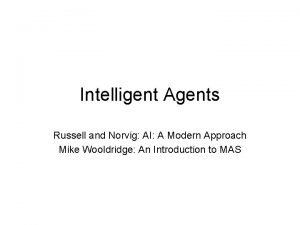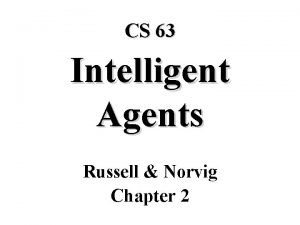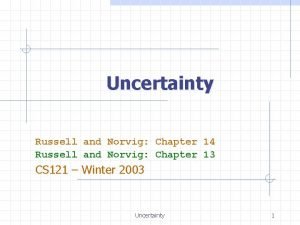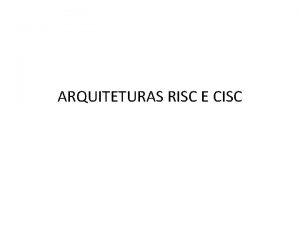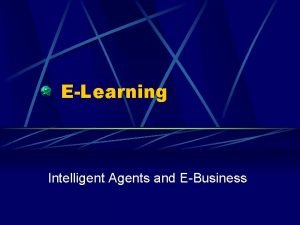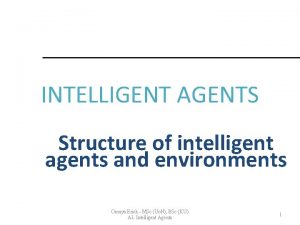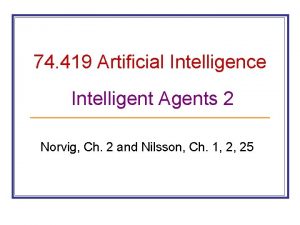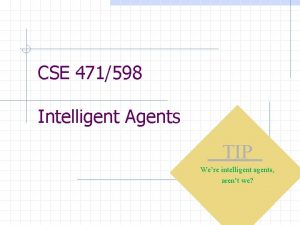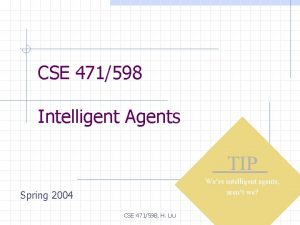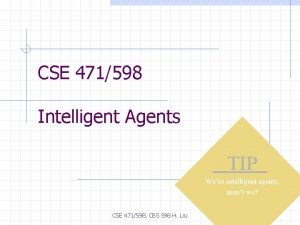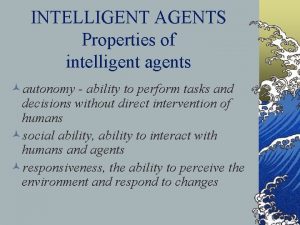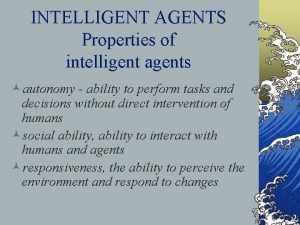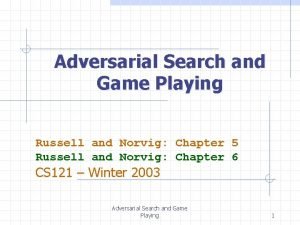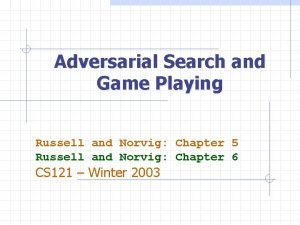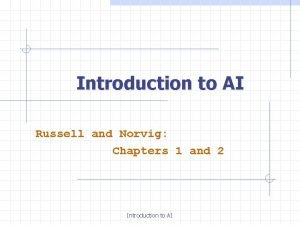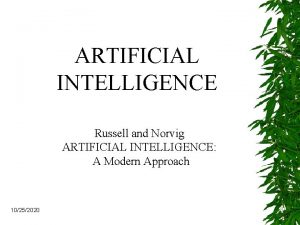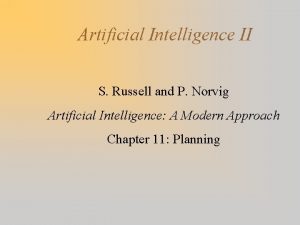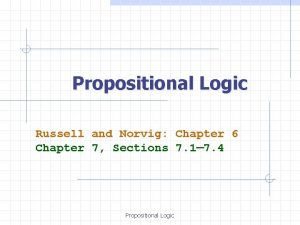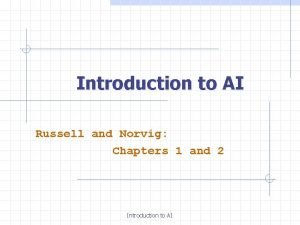Intelligent Agents Russell and Norvig 2 CISC 4681


































- Slides: 34

Intelligent Agents Russell and Norvig: 2 CISC 4/681 Introduction to Artificial Intelligence 1

Agents • Agent – perceives the environment through sensors and acts on it through actuators • Percept – agent’s perceptual input (the basis for its actions) • Percept Sequence – complete history of what has been perceived. CISC 4/681 Introduction to Artificial Intelligence 2

Agent Function • Agent Function – maps a give percept sequence into an action; describes what the agent does. • Externally – Table of actions • Internally – Agent Program CISC 4/681 Introduction to Artificial Intelligence 3

Vacuum Cleaner World • Percepts: which square (A or B); dirt? • Actions: move right, move left, suck, do nothing • Agent function: maps percept sequence into actions • Agent program: function’s implementation • How should the program act? CISC 4/681 Introduction to Artificial Intelligence 4

Agent Characterization • Meant to be a tool for analyzing systems – not characterizing them as agent versus non-agent • Lots of things can be characterized as agents (artifacts) that act on the world • AI operates where – Artifacts have significant computational resources – Task Environments require nontrivial decision making CISC 4/681 Introduction to Artificial Intelligence 5

Vacuum Cleaner World • Percepts: which square (A or B); dirt? • Actions: move right, move left, suck, do nothing • Agent function: maps percept sequence into actions • Agent program: function’s implementation • How should the program act? CISC 4/681 Introduction to Artificial Intelligence 6

Rational Agent – does the right thing What does that mean? One that behaves as well as possible given the Environment in which it acts. How should success be measured? On consequences. • Performance measure – Embodies criterion for success • Amount of dirt cleaned? • Cleaned floors? – Generally defined in terms of desired effect on environment (not on actions of agent) – Defining measure not always easy! CISC 4/681 Introduction to Artificial Intelligence 7

Rationality Depends on: 1. Performance measure that defines criterion for success. 2. Agent’s prior knowledge of the environment. 3. Actions the agent can perform. 4. Agent’s percept sequence to date. For each possible percept sequence, a rational agent should select an action that is expected to maximize its performance measure, given the evidence provided by the percept sequence and whatever built-in knowledge the agent has. CISC 4/681 Introduction to Artificial Intelligence 8

Rationality For each possible percept sequence, a rational agent should select an action that is expected to maximize its performance measure, given the evidence provided by the percept sequence and whatever builtin knowledge the agent has. • Notice the rationality is dependent on EXPECTED maximization. • Agent might need to learn how the environment changes, what action sequences to put together, etc… CISC 4/681 Introduction to Artificial Intelligence 9

Rationality For each possible percept sequence, a rational agent should select an action that is expected to maximize its performance measure, given the evidence provided by the percept sequence and whatever builtin knowledge the agent has. • Notice that an agent may be rational because the designer thought of everything, or it may have learned it itself (more autonomous) CISC 4/681 Introduction to Artificial Intelligence 10

Task Environment • The “problems” for which rational agents are the “solutions” PEAS Description of Task Environment • Performance Measure • Environment • Actuators (actions) • Sensors (what can be perceived) CISC 4/681 Introduction to Artificial Intelligence 11

Properties of Task Environments (affect appropriate agent design) • Fully observable vs partially observable – Fully observable gives access to complete state of the environment – Complete state means aspects relevant to action choice – global vs local dirt sensor CISC 4/681 Introduction to Artificial Intelligence 12

Properties of Task Environments (affect appropriate agent design) • Single Agent vs Multi-agent – Single Agent – crossword puzzle – Multi-agent – chess, taxi driving? (are other drivers best described as maximizing a performance element? ) – Multi-agent means other agents may be competitive or cooperative and may require communication – Multi-agent may need communication CISC 4/681 Introduction to Artificial Intelligence 13

Properties of Task Environments (affect appropriate agent design) • Deterministic vs Stochastic – Deterministic – next state completely determined by current state and action – Uncertainty may arise because of defective actions or partially observable state (i. e. , agent might not see everything that affects the outcome of an action). CISC 4/681 Introduction to Artificial Intelligence 14

Properties of Task Environments (affect appropriate agent design) • Episodic vs Sequential – Episodic the agent’s experience divided into atomic episodes – Next episode not dependent on actions taken in previous episode. E. g. , assembly line – Sequential – current action may affect future actions. E. g. , playing chess, taxi – short-term actions have long-term effects – must think ahead in choosing an action CISC 4/681 Introduction to Artificial Intelligence 15

Properties of Task Environments (affect appropriate agent design) • Static vs Dynamic – does environment change while agent is deliberating? – Static – crossword puzzle – Dynamic – taxi driver CISC 4/681 Introduction to Artificial Intelligence 16

Properties of Task Environments (affect appropriate agent design) • Discrete vs Continuous. Can refer to – the state of the environment (chess has finite number of discrete states) – the way time is handled (taxi driving continuous – speed and location of taxi sweep through range of continuous values) – percepts and actions (taxi driving continuous – steering angles) CISC 4/681 Introduction to Artificial Intelligence 17

Properties of Task Environments (affect appropriate agent design) • Known vs Unknown - This does not refer to the environment itself, but rather the agent’s knowledge of it and how it changes. - If unknown, the agent may need to learn CISC 4/681 Introduction to Artificial Intelligence 18

Properties of Task Environments (affect appropriate agent design) • Easy: Fully observable, Deterministic, Episodic, Static, Discrete, Single agent. • Hard: Partially observable, Sochastic, Sequential, Dynamic, Continuous, Multi. Agent CISC 4/681 Introduction to Artificial Intelligence 19

Environment types Fully observable Deterministic Episodic Static Discrete Single agent Chess with a clock Yes Strategic No Semi Yes No Chess without a clock Yes Strategic No Yes No Taxi driving No No No • The environment type largely determines the agent design • The real world is (of course) partially observable, stochastic, sequential, dynamic, continuous, multi-agent

Agent Programs • Need to develop agents – programs that take the current percept as input from the sensors and return an action to the actuators. CISC 4/681 Introduction to Artificial Intelligence 21

Possible Agent Program CISC 4/681 Introduction to Artificial Intelligence 22

Agent Programs • Need to develop agents – programs that take the current percept as input from the sensors and return an action to the actuators. • The key challenge for AI is to find out how to write programs that, to the extent possible, produce rational behavior from a small amount of code. CISC 4/681 Introduction to Artificial Intelligence 23

Simple Reflective Agent CISC 4/681 Introduction to Artificial Intelligence 24

Simple Reflexive Agent • • Handles simplest kind of world Agent embodies a set of condition-action rules If percept then action Agent simply takes in a percept, determines which action could be applied, and does that action. • NOTE: • Action dependent on current percept only • Only works in fully observable environment CISC 4/681 Introduction to Artificial Intelligence 25

Simply Reflexive Vacuum Agent • Implements the agent function (described in earlier table) CISC 4/681 Introduction to Artificial Intelligence 26

Model-Based Reflex Agent CISC 4/681 Introduction to Artificial Intelligence 27

Model-Based Reflex Agent • Upon getting a percept – Update the state (given the current state, the action you just did, and the observations) – Choose a rule to apply (whose conditions match the state) – Schedule the action associated with the chosen rule CISC 4/681 Introduction to Artificial Intelligence 28

Goal Based Agent CISC 4/681 Introduction to Artificial Intelligence 29

Utility-Based Agent CISC 4/681 Introduction to Artificial Intelligence 30

Learning agents

Learning Agent Components 1. Learning Element – responsible for making improvements (on what ever aspect is being learned…) 2. Performance Element – responsible for selecting external actions. In previous parts, this was the entire agent! 3. Critic – gives feedback on how agent is going and determines how performance element should be modified to do better in the future 4. Problem Generator – suggests actions for new and informative experiences. CISC 4/681 Introduction to Artificial Intelligence 32

Summary Chapter 2 • Agents interact with environments through actuators and sensors • The agent function describes what the agent does in all circumstances. • The performance measure evaluates the environment sequence. • A perfectly rational agent maximizes expected performance. • Agent programs implement (some) agent functions. CISC 4/681 Introduction to Artificial Intelligence 33

Summary (cont) • PEAS descriptions define task environments. • Environments are categorized along several dimensions: – Observable? Deterministic? Episodic? Static? Discrete? Single-agent? • Several basic agent architectures exist: – Reflex, reflex with state, goal-based, utilitybased CISC 4/681 Introduction to Artificial Intelligence 34
 Russel and norvig
Russel and norvig How dogs communicate
How dogs communicate Russell norvig
Russell norvig 236501
236501 Ai peas
Ai peas Table-driven agent example
Table-driven agent example Googleö
Googleö Peter norvig design patterns
Peter norvig design patterns Russel norvig
Russel norvig Wei bin
Wei bin Risc vs cisc vs mips
Risc vs cisc vs mips Flynn's taxonomy
Flynn's taxonomy Risc vs cisc
Risc vs cisc Cisc 101
Cisc 101 Contoh prosesor risc
Contoh prosesor risc Characteristics of cisc architecture
Characteristics of cisc architecture Cisc vs risc
Cisc vs risc Cisc 1050
Cisc 1050 Architettura cisc
Architettura cisc Cisc pipeline
Cisc pipeline Architettura cisc
Architettura cisc Risc, cisc
Risc, cisc Cisc 3140
Cisc 3140 Ciri ciri cisc
Ciri ciri cisc Cisc processor examples
Cisc processor examples Cisc
Cisc Goetz 1003
Goetz 1003 Cisc assembly language
Cisc assembly language Cisc complex instruction set computer
Cisc complex instruction set computer Cisc 3130
Cisc 3130 Cisc 181
Cisc 181 Arduino risc or cisc
Arduino risc or cisc Cisc scalar processor
Cisc scalar processor Isa
Isa Cisc cu boulder
Cisc cu boulder

